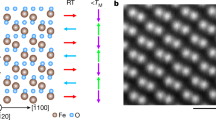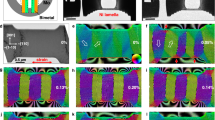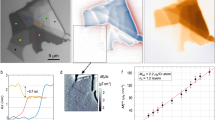Abstract
Nanoscale magnetic imaging can provide microscopic information about length scales, inhomogeneity and interactions of materials systems. As such, it is a powerful tool to probe phenomena such as superconductivity, Mott insulating states and magnetically ordered states in 2D materials, which are sensitive to the local environment. This Technical Review provides an analysis of weak magnetic field imaging techniques that are most promising for the study of 2D materials: magnetic force microscopy, scanning superconducting quantum interference device microscopy and scanning nitrogen-vacancy centre microscopy.
Key points
-
Scanning magnetic probes have developed into powerful techniques for imaging magnetization patterns, spin configurations and current distributions with high spatial resolution and high sensitivity.
-
These local probes give crucial insights into length scales, inhomogeneity and interactions that are often absent from bulk measurements of transport, magnetization, susceptibility or heat capacity.
-
Using these techniques to image the recently discovered correlated states hosted in 2D materials will provide crucial local information on quantum phases, including on the spatial variation of order parameters, the presence of domains and the role of defects.
-
Correlated states in 2D systems are extremely sensitive to disorder and inhomogeneity. In such a fragile environment, local measurements — with sensors whose characteristic size is smaller than the length scale of the disorder — are essential for making sense of the system.
-
It is important to choose the appropriate scanning magnetic probe for the physical system under investigation: the different scaling of magnetization and current contrast with probe–sample spacing and the different physical quantities that are measured by each probe make certain techniques more amenable to certain systems.
This is a preview of subscription content, access via your institution
Access options
Access Nature and 54 other Nature Portfolio journals
Get Nature+, our best-value online-access subscription
$29.99 / 30 days
cancel any time
Subscribe to this journal
Receive 12 digital issues and online access to articles
$99.00 per year
only $8.25 per issue
Buy this article
- Purchase on Springer Link
- Instant access to full article PDF
Prices may be subject to local taxes which are calculated during checkout



Similar content being viewed by others
References
Freeman, M. R. & Choi, B. C. Advances in magnetic microscopy. Science 294, 1484–1488 (2001).
McCord, J. Progress in magnetic domain observation by advanced magneto-optical microscopy. J. Phys. D 48, 333001 (2015).
Rougemaille, N. & Schmid, A. K. Magnetic imaging with spin-polarized low-energy electron microscopy. Eur. Phys. J. 50, 20101 (2010).
Stoll, H. et al. Imaging spin dynamics on the nanoscale using X-Ray microscopy. Front. Phys. 3, 26 (2015).
Bonetti, S. X-ray imaging of spin currents and magnetisation dynamics at the nanoscale. J. Phys. Condens. Matter 29, 133004 (2017).
Fischer, P. Magnetic imaging with polarized soft X-rays. J. Phys. D 50, 313002 (2017).
Belova, L. M., Hellwig, O., Dobisz, E. & Dan Dahlberg, E. Rapid preparation of electron beam induced deposition co magnetic force microscopy tips with 10 Nm spatial resolution. Rev. Sci. Instrum. 83, 093711 (2012).
Jaafar, M. et al. Customized MFM probes based on magnetic nanorods. Nanoscale 12, 10090–10097 (2020).
Schnez, S. et al. Imaging localized states in graphene nanostructures. Phys. Rev. B 82, 165445 (2010).
Lee, K. et al. Ultrahigh-resolution scanning microwave impedance microscopy of moiré lattices and superstructures. Sci. Adv. 6, eabd1919 (2020).
Quang, T. L. et al. Scanning tunneling spectroscopy of van der Waals graphene/semiconductor interfaces: absence of Fermi level pinning. 2D Mater. 4, 035019 (2017).
Woessner, A. et al. Highly confined low-loss plasmons in graphene–boron nitride heterostructures. Nat. Mater. 14, 421–425 (2015).
Uri, A. et al. Mapping the twist-angle disorder and Landau levels in magic-angle graphene. Nature 581, 47–52 (2020).
Tschirhart, C. L. et al. Imaging orbital ferromagnetism in a moiré Chern insulator. Science 372, 1323–1327 (2021).
Uri, A. et al. Nanoscale imaging of equilibrium quantum Hall edge currents and of the magnetic monopole response in graphene. Nat. Phys. 16, 164–170 (2020).
Aharon-Steinberg, A. et al. Long-range nontopological edge currents in charge-neutral graphene. Nature 593, 528–534 (2021).
Thiel, L. et al. Probing magnetism in 2D materials at the nanoscale with single-spin microscopy. Science 364, 973–976 (2019).
Sun, Q.-C. et al. Magnetic domains and domain wall pinning in two-dimensional ferromagnets revealed by nanoscale imaging. Nat. Commun. 12, 1989 (2021).
Fabre, F. et al. Characterization of room-temperature in-plane magnetization in thin flakes of CrTe2 with a single-spin magnetometer. Phys. Rev. Mater. 5, 034008 (2021).
Jenkins, A. et al. Imaging the breakdown of ohmic transport in graphene. Preprint at arXiv https://arxiv.org/abs/2002.05065 (2020).
Ku, M. J. H. et al. Imaging viscous flow of the Dirac fluid in graphene. Nature 583, 537–541 (2020).
Vool, U. et al. Imaging phonon-mediated hydrodynamic flow in WTe2 with cryogenic quantum magnetometry. Preprint at arXiv https://arxiv.org/abs/2009.04477 (2020).
Huang, B. et al. Layer-dependent ferromagnetism in a van der Waals crystal down to the monolayer limit. Nature 546, 270–273 (2017).
Chen, W. et al. Direct observation of van der Waals stacking–dependent interlayer magnetism. Science 366, 983–987 (2019).
Yang, M. et al. Creation of skyrmions in van der Waals ferromagnet Fe3GeTe2 on (Co/Pd)n superlattice. Sci. Adv. 6, eabb5157 (2020).
Li, Q. et al. Patterning-induced ferromagnetism of Fe3GeTe2 van der Waals materials beyond room temperature. Nano Lett. 18, 5974–5980 (2018).
Huang, B. et al. Emergent phenomena and proximity effects in two-dimensional magnets and heterostructures. Nat. Mater. 19, 1276–1289 (2020).
Kirtley, J. R. Fundamental studies of superconductors using scanning magnetic imaging. Rep. Prog. Phys. 73, 126501 (2010).
Martin, Y. & Wickramasinghe, H. K. Magnetic imaging by “force microscopy” with 1000 Å resolution. Appl. Phys. Lett. 50, 1455–1457 (1987).
Sáenz, J. J. et al. Observation of magnetic forces by the atomic force microscope. J. Appl. Phys. 62, 4293–4295 (1987).
Schmid, I. et al. Exchange bias and domain evolution at 10 nm scales. Phys. Rev. Lett. 105, 197201 (2010).
Moser, A. et al. High-resolution magnetic force microscopy study of high-density transitions in perpendicular recording media. J. Magn. Magn. Mater. 287, 298–302 (2005).
Rossi, N. et al. Vectorial scanning force microscopy using a nanowire sensor. Nat. Nanotechnol. 12, 150–155 (2017).
de Lépinay, L. M. et al. A universal and ultrasensitive vectorial nanomechanical sensor for imaging 2D force fields. Nat. Nanotechnol. 12, 156–162 (2017).
Siria, A. & Niguès, A. Electron beam detection of a nanotube scanning force microscope. Sci. Rep. 7, 11595 (2017).
Poggio, M. Nanomechanics: sensing from the bottom up. Nat. Nanotechnol. 8, 482–483 (2013).
Nichol, J. M., Hemesath, E. R., Lauhon, L. J. & Budakian, R. Nanomechanical detection of nuclear magnetic resonance using a silicon nanowire oscillator. Phys. Rev. B 85, 054414 (2012).
van Schendel, P. J. A., Hug, H. J., Stiefel, B., Martin, S. & Güntherodt, H.-J. A method for the calibration of magnetic force microscopy tips. J. Appl. Phys. 88, 435–445 (2000).
Mattiat, H. et al. Nanowire magnetic force sensors fabricated by focused-electron-beam-induced deposition. Phys. Rev. Appl. 13, 044043 (2020).
Rossi, N., Gross, B., Dirnberger, F., Bougeard, D. & Poggio, M. Magnetic force sensing using a self-assembled nanowire. Nano Lett. 19, 930–936 (2019).
Sansa, M. et al. Frequency fluctuations in silicon nanoresonators. Nat. Nanotechnol. 11, 552–558 (2016).
Cao, Y. et al. Unconventional superconductivity in magic-angle graphene superlattices. Nature 556, 43–50 (2018).
Fatemi, V. et al. Electrically tunable low-density superconductivity in a monolayer topological insulator. Science 362, 926–929 (2018).
Sajadi, E. et al. Gate-induced superconductivity in a monolayer topological insulator. Science 362, 922–925 (2018).
Roch, J. G. et al. Spin-polarized electrons in monolayer MoS2. Nat. Nanotechnol. 14, 432–436 (2019).
Roch, J. G. et al. First-order magnetic phase transition of mobile electrons in monolayer MoS2. Phys. Rev. Lett. 124, 187602 (2020).
Grütter, P., Liu, Y., LeBlanc, P. & Dürig, U. Magnetic dissipation force microscopy. Appl. Phys. Lett. 71, 279–281 (1997).
Kisiel, M. et al. Suppression of electronic friction on Nb films in the superconducting state. Nat. Mater. 10, 119–122 (2011).
Kisiel, M. et al. Noncontact atomic force microscope dissipation reveals a central peak of SrTiO3 structural phase transition. Phys. Rev. Lett. 115, 046101 (2015).
Rogers, F. P. A Device for Experimental Observation of Flux Vortices Trapped in Superconducting Thin Film. Thesis, Massachusetts Inst. Technol. (1983).
Finkler, A. et al. Scanning superconducting quantum interference device on a tip for magnetic imaging of nanoscale phenomena. Rev. Sci. Instrum. 83, 073702 (2012).
Ceccarelli, L. Scanning Probe Microscopy with SQUID-on-tip Sensor. Thesis, Univ. Basel (2020).
Kirtley, J. R. et al. Scanning SQUID susceptometers with sub-micron spatial resolution. Rev. Sci. Instrum. 87, 093702 (2016).
Finkler, A. et al. Self-aligned nanoscale SQUID on a tip. Nano Lett. 10, 1046–1049 (2010).
Bagani, K. et al. Sputtered Mo66Re34 SQUID-on-tip for high-field magnetic and thermal nanoimaging. Phys. Rev. Appl. 12, 044062 (2019).
Vasyukov, D. et al. A scanning superconducting quantum interference device with single electron spin sensitivity. Nat. Nanotechnol. 8, 639–644 (2013).
Tesche, C. D. & Clarke, J. dc SQUID: noise and optimization. J. Low Temp. Phys. 29, 301–331 (1977).
Mitchell, M. W. & Alvarez, S. P. Colloquium: Quantum limits to the energy resolution of magnetic field sensors. Rev. Mod. Phys. 92, 021001 (2020).
Geller, M. R. & Vignale, G. Currents in the compressible and incompressible regions of the two-dimensional electron gas. Phys. Rev. B 50, 11714 (1994).
Cooper, N. R., Halperin, B. I. & Ruzin, I. M. Thermoelectric response of an interacting two-dimensional electron gas in a quantizing magnetic field. Phys. Rev. B 55, 2344 (1997).
Weis, J. & von Klitzing, K. Metrology and microscopic picture of the integer quantum Hall effect. Phil. Trans. R. Soc. A 369, 3954–3974 (2011).
Feldman, B. E., Krauss, B., Smet, J. H. & Yacoby, A. Unconventional sequence of fractional quantum Hall states in suspended graphene. Science 337, 1196–1199 (2012).
Suddards, M. E., Baumgartner, A., Henini, M. & Mellor, C. J. Scanning capacitance imaging of compressible and incompressible quantum Hall effect edge strips. New J. Phys. 14, 083015 (2012).
Halbertal, D. et al. Nanoscale thermal imaging of dissipation in quantum systems. Nature 539, 407–410 (2016).
Halbertal, D. et al. Imaging resonant dissipation from individual atomic defects in graphene. Science 358, 1303–1306 (2017).
Andrei, E. Y. et al. The marvels of moiré materials. Nat. Rev. Mater. 6, 201–206 (2021).
Degen, C. L. Scanning magnetic field microscope with a diamond single-spin sensor. Appl. Phys. Lett. 92, 243111 (2008).
Balasubramanian, G. et al. Nanoscale imaging magnetometry with diamond spins under ambient conditions. Nature 455, 648–651 (2008).
Gruber, A. et al. Scanning confocal optical microscopy and magnetic resonance on single defect centers. Science 276, 2012–2014 (1997).
Felton, S. et al. Hyperfine interaction in the ground state of the negatively charged nitrogen vacancy center in diamond. Phys. Rev. B 79, 075203 (2009).
Schirhagl, R., Chang, K., Loretz, M. & Degen, C. L. Nitrogen-vacancy centers in diamond: nanoscale sensors for physics and biology. Annu. Rev. Phys. Chem. 65, 83–105 (2014).
Epstein, R. J., Mendoza, F. M., Kato, Y. K. & Awschalom, D. D. Anisotropic interactions of a single spin and dark-spin spectroscopy in diamond. Nat. Phys. 1, 94–98 (2005).
Tetienne, J.-P. et al. Magnetic-field-dependent photodynamics of single NV defects in diamond: an application to qualitative all-optical magnetic imaging. New J. Phys. 14, 103033 (2012).
Ariyaratne, A., Bluvstein, D., Myers, B. A. & Jayich, A. C. B. Nanoscale electrical conductivity imaging using a nitrogen-vacancy center in diamond. Nat. Commun. 9, 2406 (2018).
Wolfe, C. S. et al. Off-resonant manipulation of spins in diamond via precessing magnetization of a proximal ferromagnet. Phys. Rev. B 89, 180406 (2014).
van der Sar, T., Casola, F., Walsworth, R. & Yacoby, A. Nanometre-scale probing of spin waves using single electron spins. Nat. Commun. 6, 7886 (2015).
Bertelli, I. et al. Magnetic resonance imaging of spin-wave transport and interference in a magnetic insulator. Sci. Adv. 6, eabd3556 (2020).
Álvarez, G. A. & Suter, D. Measuring the spectrum of colored noise by dynamical decoupling. Phys. Rev. Lett. 107, 230501 (2011).
Degen, C. L., Reinhard, F. & Cappellaro, P. Quantum sensing. Rev. Mod. Phys. 89, 035002 (2017).
Maletinsky, P. et al. A robust scanning diamond sensor for nanoscale imaging with single nitrogen-vacancy centres. Nat. Nanotechnol. 7, 320–324 (2012).
Ofori-Okai, B. K. et al. Spin properties of very shallow nitrogen vacancy defects in diamond. Phys. Rev. B 86, 081406 (2012).
Wornle, M. S. et al. Coexistence of Bloch and Néel walls in a collinear antiferromagnet. Phys. Rev. B 103, 094426 (2021).
Chang, K., Eichler, A., Rhensius, J., Lorenzelli, L. & Degen, C. L. Nanoscale imaging of current density with a single-spin magnetometer. Nano Lett. 17, 2367–2373 (2017).
Budker, D. & Romalis, M. Optical magnetometry. Nat. Phys. 3, 227–234 (2007).
Balasubramanian, G. et al. Ultralong spin coherence time in isotopically engineered diamond. Nat. Mater. 8, 383–387 (2009).
de Lange, G., Ristè, D., Dobrovitski, V. V. & Hanson, R. Single-spin magnetometry with multipulse sensing sequences. Phys. Rev. Lett. 106, 080802 (2011).
Hopper, D. A., Lauigan, J. D., Huang, T.-Y. & Bassett, L. C. Real-time charge initialization of diamond nitrogen-vacancy centers for enhanced spin readout. Phys. Rev. Appl. 13, 024016 (2020).
Momenzadeh, S. A. et al. Nanoengineered diamond waveguide as a robust bright platform for nanomagnetometry using shallow nitrogen vacancy centers. Nano Lett. 15, 165–169 (2015).
Wan, N. H. et al. Efficient extraction of light from a nitrogen-vacancy center in a diamond parabolic reflector. Nano Lett. 18, 2787–2793 (2018).
Lee, M. et al. Mapping current profiles of point-contacted graphene devices using single-spin scanning magnetometer. Appl. Phys. Lett. 118, 033101 (2021).
Gong, C. et al. Discovery of intrinsic ferromagnetism in two-dimensional van der Waals crystals. Nature 546, 265–269 (2017).
Jiang, S., Li, L., Wang, Z., Mak, K. F. & Shan, J. Controlling magnetism in 2D CrI3 by electrostatic doping. Nat. Nanotechnol. 13, 549–553 (2018).
Fei, Z. et al. Two-dimensional itinerant ferromagnetism in atomically thin Fe3GeTe2. Nat. Mater. 17, 778–782 (2018).
Du, C. et al. Control and local measurement of the spin chemical potential in a magnetic insulator. Science 357, 195–198 (2017).
Stipe, B. C., Mamin, H. J., Stowe, T. D., Kenny, T. W. & Rugar, D. Noncontact friction and force fluctuations between closely spaced bodies. Phys. Rev. Lett. 87, 096801 (2001).
Beardsley, I. A. Reconstruction of the magnetization in a thin film by a combination of Lorentz microscopy and external field measurements. IEEE Trans. Magn. 25, 671–677 (1989).
Braakman, F. R. & Poggio, M. Force sensing with nanowire cantilevers. Nanotechnology 30, 332001 (2019).
Koblischka, M. R., Hartmann, U. & Sulzbach, T. Improving the lateral resolution of the MFM technique to the 10nm range. J. Magn. Magn. Mater. 272–276, 2138–2140 (2004).
Gao, L. et al. Focused Ion beam milled CoPt magnetic force microscopy tips for high resolution domain images. IEEE Trans. Magn. 40, 2194–2196 (2004).
Müller, B. et al. Josephson junctions and squids created by focused helium-ion-beam irradiation of YBa2Cu3O7. Phys. Rev. Appl. 11, 044082 (2019).
Sangtawesin, S. et al. Origins of diamond surface noise probed by correlating single-spin measurements with surface spectroscopy. Phys. Rev. X 9, 031052 (2019).
Yamaoka, T. et al. Vacuum magnetic force microscopy at high temperatures: observation of permanent magnets. Microsc. Today 22, 12–17 (2014).
Jeffery, M., Van Duzer, T., Kirtley, J. R. & Ketchen, M. B. Magnetic imaging of moat-guarded superconducting electronic circuits. Appl. Phys. Lett. 67, 1769–1771 (1995).
Zhigao, S. et al. Visualization of electronic multiple ordering and its dynamics in high magnetic field: evidence of electronic multiple ordering crystals. ACS Appl. Mater. Interfaces 10, 20136–20141 (2018).
Roth, B. J., Sepulveda, N. G. & Wikswo, J. P. Using a magnetometer to image a two-dimensional current distribution. J. Appl. Phys. 65, 361–372 (1989).
Acknowledgements
We thank H.-J. Hug, J. Kirtley and A. Kleibert for insightful discussions. We acknowledge the support of the Canton Aargau and the Swiss National Science Foundation under project grant 200020-178863, via the Sinergia grant Nanoskyrmionics (grant no. CRSII5-171003) and via the NCCR Quantum Science and Technology (QSIT). C.L.D. acknowledges funding by the Swiss National Science Foundation under project grant 20020-175600, by the European Commission under grant no. 820394 ASTERIQS and by the European Research Council under grant 817720 IMAGINE.
Author information
Authors and Affiliations
Contributions
All authors researched data for the article, carried out calculations and contributed substantially to discussion of the content. L.C. made the figures, with input from E.M., N.R., C.L.D. and M.P. M.P. wrote the text, with input from E.M., L.L. and C.L.D. All authors reviewed the manuscript before submission.
Corresponding author
Ethics declarations
Competing interests
The authors declare no competing interests.
Additional information
Peer review information
Nature Reviews Physics thanks Ruslan Prozorov and the other, anonymous, reviewer(s) for their contribution to the peer review of this work.
Publisher’s note
Springer Nature remains neutral with regard to jurisdictional claims in published maps and institutional affiliations.
Rights and permissions
About this article
Cite this article
Marchiori, E., Ceccarelli, L., Rossi, N. et al. Nanoscale magnetic field imaging for 2D materials. Nat Rev Phys 4, 49–60 (2022). https://doi.org/10.1038/s42254-021-00380-9
Accepted:
Published:
Issue Date:
DOI: https://doi.org/10.1038/s42254-021-00380-9
This article is cited by
-
Nitrogen-vacancy magnetometry of CrSBr by diamond membrane transfer
npj 2D Materials and Applications (2023)
-
Evidence of non-collinear spin texture in magnetic moiré superlattices
Nature Physics (2023)
-
Sub-micron spin-based magnetic field imaging with an organic light emitting diode
Nature Communications (2023)
-
Fundamental quantum limits of magnetic nearfield measurements
npj Quantum Information (2023)
-
Accurate magnetic field imaging using nanodiamond quantum sensors enhanced by machine learning
Scientific Reports (2022)



